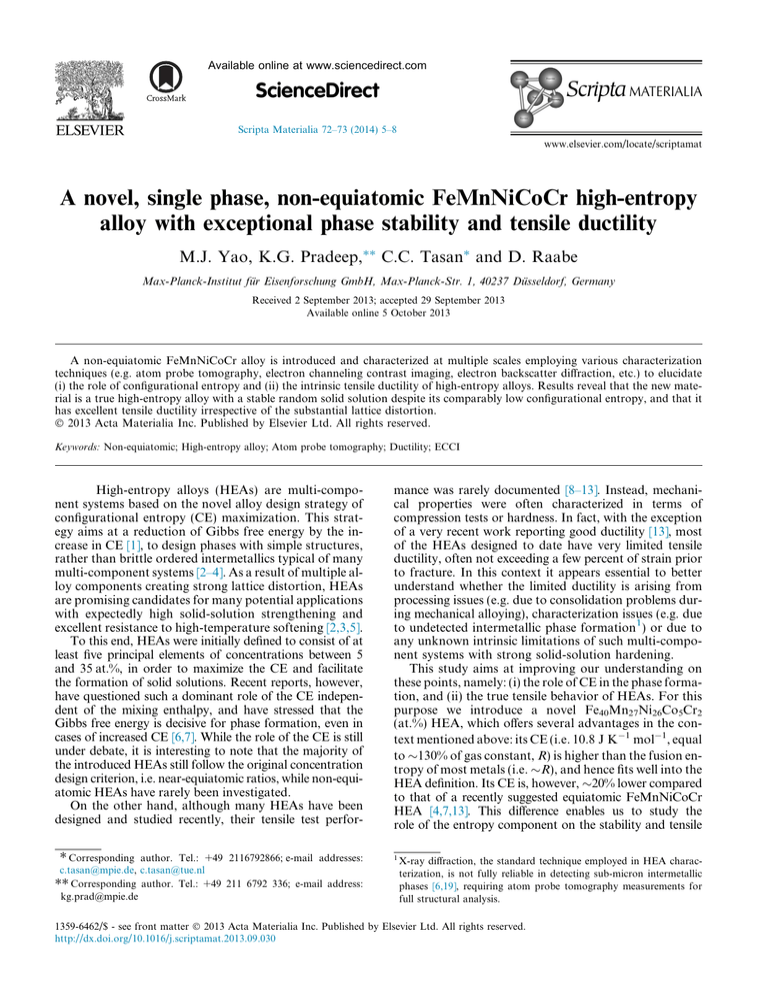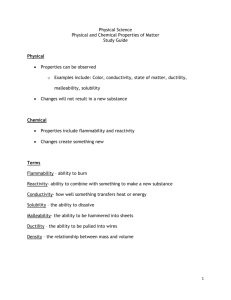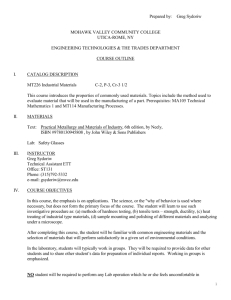
Available online at www.sciencedirect.com
ScienceDirect
Scripta Materialia 72–73 (2014) 5–8
www.elsevier.com/locate/scriptamat
A novel, single phase, non-equiatomic FeMnNiCoCr high-entropy
alloy with exceptional phase stability and tensile ductility
M.J. Yao, K.G. Pradeep,⇑⇑ C.C. Tasan⇑ and D. Raabe
Max-Planck-Institut für Eisenforschung GmbH, Max-Planck-Str. 1, 40237 Düsseldorf, Germany
Received 2 September 2013; accepted 29 September 2013
Available online 5 October 2013
A non-equiatomic FeMnNiCoCr alloy is introduced and characterized at multiple scales employing various characterization
techniques (e.g. atom probe tomography, electron channeling contrast imaging, electron backscatter diffraction, etc.) to elucidate
(i) the role of configurational entropy and (ii) the intrinsic tensile ductility of high-entropy alloys. Results reveal that the new material is a true high-entropy alloy with a stable random solid solution despite its comparably low configurational entropy, and that it
has excellent tensile ductility irrespective of the substantial lattice distortion.
Ó 2013 Acta Materialia Inc. Published by Elsevier Ltd. All rights reserved.
Keywords: Non-equiatomic; High-entropy alloy; Atom probe tomography; Ductility; ECCI
High-entropy alloys (HEAs) are multi-component systems based on the novel alloy design strategy of
configurational entropy (CE) maximization. This strategy aims at a reduction of Gibbs free energy by the increase in CE [1], to design phases with simple structures,
rather than brittle ordered intermetallics typical of many
multi-component systems [2–4]. As a result of multiple alloy components creating strong lattice distortion, HEAs
are promising candidates for many potential applications
with expectedly high solid-solution strengthening and
excellent resistance to high-temperature softening [2,3,5].
To this end, HEAs were initially defined to consist of at
least five principal elements of concentrations between 5
and 35 at.%, in order to maximize the CE and facilitate
the formation of solid solutions. Recent reports, however,
have questioned such a dominant role of the CE independent of the mixing enthalpy, and have stressed that the
Gibbs free energy is decisive for phase formation, even in
cases of increased CE [6,7]. While the role of the CE is still
under debate, it is interesting to note that the majority of
the introduced HEAs still follow the original concentration
design criterion, i.e. near-equiatomic ratios, while non-equiatomic HEAs have rarely been investigated.
On the other hand, although many HEAs have been
designed and studied recently, their tensile test perfor-
⇑ Corresponding author. Tel.: +49 2116792866; e-mail addresses:
c.tasan@mpie.de, c.tasan@tue.nl
⇑⇑ Corresponding author. Tel.: +49 211 6792 336; e-mail address:
kg.prad@mpie.de
mance was rarely documented [8–13]. Instead, mechanical properties were often characterized in terms of
compression tests or hardness. In fact, with the exception
of a very recent work reporting good ductility [13], most
of the HEAs designed to date have very limited tensile
ductility, often not exceeding a few percent of strain prior
to fracture. In this context it appears essential to better
understand whether the limited ductility is arising from
processing issues (e.g. due to consolidation problems during mechanical alloying), characterization issues (e.g. due
to undetected intermetallic phase formation1) or due to
any unknown intrinsic limitations of such multi-component systems with strong solid-solution hardening.
This study aims at improving our understanding on
these points, namely: (i) the role of CE in the phase formation, and (ii) the true tensile behavior of HEAs. For this
purpose we introduce a novel Fe40Mn27Ni26Co5Cr2
(at.%) HEA, which offers several advantages in the context mentioned above: its CE (i.e. 10.8 J K 1 mol 1, equal
to 130% of gas constant, R) is higher than the fusion entropy of most metals (i.e. R), and hence fits well into the
HEA definition. Its CE is, however, 20% lower compared
to that of a recently suggested equiatomic FeMnNiCoCr
HEA [4,7,13]. This difference enables us to study the
role of the entropy component on the stability and tensile
1
X-ray diffraction, the standard technique employed in HEA characterization, is not fully reliable in detecting sub-micron intermetallic
phases [6,19], requiring atom probe tomography measurements for
full structural analysis.
1359-6462/$ - see front matter Ó 2013 Acta Materialia Inc. Published by Elsevier Ltd. All rights reserved.
http://dx.doi.org/10.1016/j.scriptamat.2013.09.030
6
M. J. Yao et al. / Scripta Materialia 72–73 (2014) 5–8
behavior of HEAs. Also, the effects of consolidation issues
or brittle intermetallic phases are ruled out through liquid-metallurgical processing and characterization down
to the atomic scale, allowing assessment of the intrinsic
tensile ductility of the designed material.
The alloy was melted from pure metals (purity > 99.8 wt.%) in a vacuum induction furnace, cast into a
water-cooled copper mold and furnace-cooled. Following
hot-rolling to 50% thickness reduction at 900 °C, it was
homogenized at 1200 °C for 2 h in Ar atmosphere, and
quenched in water. Further grain refinement was achieved
through cold-rolling to 64% thickness reduction and subsequent 900 °C annealing in Ar atmosphere for 10 min.
The characterization of phase formation and thermal
stability was carried out by X-ray diffraction (XRD) and
differential scanning calorimetry (DSC), respectively.
During XRD, specimens were mounted on a Huber-2
goniometer and exposed to Co Ka radiation
(k = 1.79 Å). The Metero0D detector swept a 2h range
from 0° to 120° with a step size of D2h = 0.05°. DSC
experiments were performed in a SETARAM Setsys
16/18 device between 20 °C and 1300 °C at different
rates (5–10 K min 1) in Ar atmosphere.
Microstructure characterization was carried out on ascast, hot-rolled, homogenized, cold-rolled and recrystallized
samples. Here we focus on the homogenized state. Secondary electron (SE) imaging, energy-dispersive X-ray spectroscopy (EDX) and electron backscatter diffraction (EBSD)
were conducted in a 6500F JEOL field emission gun-scanning electron microscope (FEG-SEM) equipped with an
EDAX software and a TSL OIM EBSD system. Elemental
distribution at atomic scale was studied using a local electrode atom probe tomography (APT) (LEAP 3000X HR,
Cameca Inc.). Tip specimens for APT were prepared in a
FEI Helios Nanolab 600i dual-beam focused ion beam
(FIB) device as described in Ref. [14]. To verify the chemical
homogeneity in the vicinity of grain boundaries (most favorable positions for intermetallics [6]), two tips were lifted out
from areas adjacent to a grain boundary, one from a
(<0 01>//ND) oriented grain and the other from a
(<1 11>//ND) oriented grain.
Mechanical properties of homogenized, cold-rolled and
recrystallized states were evaluated at room temperature,
with a strain rate of 2.5 10 3 s 1 using a Kammrath &
Weiss stage and dog-bone-shaped specimens of gauge
geometry of 4 mm 2 mm 1 mm. For trace analysis,
samples with a gauge geometry of 10 mm 7 mm 1 mm
were deformed to 3%, 13% and 28% strain. Prior to tensile
deformation, one surface of these samples was polished
for trace analysis, while a speckle pattern was applied to
the other surface for digital image correlation analysis (Aramis, GOM GmbH) [15,16].
To reveal the deformation mechanisms, microstructures
of homogenized samples were investigated after the tests
using multi-focus imaging with a Leica DM 4000M optical
microscope (OM) for trace analysis, and quantitative electron channeling contrast imaging (ECCI) [17] in a FEG/
FIB dual-beam Zeiss-crossbeam XB1560 FIB-SEM, for
the evolution of the dislocation structures.
First, XRD and DSC results of the as-cast and homogenized states are presented (Fig. 1). Both XRD patterns
show only single-phase face-centered cubic (fcc) peaks
(lattice parameter = 3.60 Å), indicating a single-phase
Figure 1. (a) XRD patterns and (b) DSC heating curves of as-cast and
homogenized states.
solid solution in both states. DSC heating curves obtained
at a low heating rate of 5 K min 1 reveal no exothermic or
endothermic phase transformation peaks up to melting
point (1250 °C). These data show that the material consists of a very stable fcc phase.
Figure 2a and b shows the homogenized alloy in fully
recrystallized state with equiaxed grains containing
annealing twins. The EBSD scan at the same area
(1 lm step size) (Fig. 2c) and high-resolution EBSD
measurements (100 nm step size) (Fig. 2d) confirm the
presence of a single fcc phase. Unindexed points arise
from 0.6 vol.% porosity.
For mapping the compositional homogeneity, EDX
maps of the same area in Figure 2b and c are presented
(Fig. 2e). All elements are homogeneously distributed, except for some minor inhomogeneity due to the formation
of manganese oxides, which is a typical processing effect
in high Mn alloys [7,12]. For studying chemical homogeneity at atomic scale, APT measurements were carried
out: no segregation or enrichment was observed in the
analyzed volumes of 98 97 117 nm3 and 90 90 141 nm3 of representative concentrations Fe40.3Mn26.0
Ni25.6Co6.1Cr2.0
and
Fe40.8Mn27.1Ni24.1Co5.7Cr2.3
(Fig. 2f and g), respectively. One-dimensional concentration–depth profiles of all elements are plotted along a
cylindrical region of interest with a diameter of 10 nm
through the analyzed volume, revealing no statistically
significant concentration fluctuations (Fig. 2f2 and g2).
The statistics of the elemental distribution are further
quantified by a binomial analysis. The frequency distribution of the elemental concentrations in both analyzed volume portions matches the reference binomial random
distributions very well (Fig. 2f3 and g3). The relative deviation from randomness is evaluated in terms of several
parameters, as listed in the inset table. l, as a normalized
auto-correlation parameter of v2, can assume values between 0 and 1, where 0 represents randomness and 1 represents complete association with solutes of the same type
[18]. In the two analyzed tips, all elements show l values
close to 0, i.e. practically complete randomness. All these
analyses give proof of a random single fcc solid solution,
confirmed down to atomic scale.
These results enable us to come back to the first discussion point mentioned above, namely to the role of
CE on phase formation in multi-component alloys.
Despite its significantly lower CE compared to the equiatomic FeMnNiCoCr system [7], the introduced nonequiatomic HEA consists of a very stable single phase
solution up to the melting point. This result supports
previous work, where the formation of multiple phases
M. J. Yao et al. / Scripta Materialia 72–73 (2014) 5–8
7
Figure 2. Homogenized microstructure: (a) OM image; (b) SE image; (c, d) low- and high-resolution EBSD phase maps with image quality overlay;
(e) EDX maps of the same area; (f, g) element distribution analyses from two APT tips. The three-dimensional elemental maps, individual elemental
distributions, concentration–depth profiles of all elements (bin size of 1 nm) and binomial distribution of analyzed data in comparison to the
theoretical binomial random distribution are provided respectively from (0) to (3).
in equiatomic HEAs with high CE were reported [6,19],
on the relatively indecisive role of maximizing the CE as
an essential criterion for the overall phase formation in
HEAs. It can, therefore, be concluded, considering the
composition and constitution of the alloy presented
here, that the original design criterion on component
composition of 5–35 at.% is not a fully sufficient (or necessary) requirement for achieving single phase solutions
in multi-component systems.
Figure 3 shows the mechanical behavior of the new
HEA in a homogenized state, exhibiting a yield strength
(YS) of 95 MPa, an ultimate tensile strength (UTS) of
375 MPa and a total elongation (TE) of 58%. Despite its low YS, the alloy possesses an excellent strainhardening capability and thus very high ductility. This
excellent mechanical response is attributed to the presence of a single fcc phase microstructure that is free of
any intermetallics or ordered phases.
Cold-rolling increases UTS to 760 MPa but reduces
ductility to 17%. The EBSD map of the cold-rolled state
before the tensile test shows a microstructure consisting
of 99% fcc phase with low pattern quality near grain
boundaries, likely due to high dislocation densities
(Fig. 3a). No phase transformation is observed, either before or after the tensile test, confirming the stability of the
fcc phase, also when subjected to heavy plastic deformation. The increase in UTS is attributed to massive dislocation–dislocation interactions, while the ductility
deteriorates due to the gradual loss in compensating
strain localization by retained strain hardening [20].
Follow-up annealing at 900 °C for 10 min produces
an average grain size of 12 lm, i.e. 50% of the
Figure 3. Stress–strain curves of different states. Inset shows EBSD phase
and IQ maps of undeformed (a) cold-rolled and (b) recrystallized samples.
homogenized state (Fig. 3b). The YS and UTS are significantly enhanced by grain refinement (150% to
240 MPa, and 72% to 645 MPa, respectively) with
no reduction in ductility. This unexpectedly strong Hall–
Petch effect suggests not only an efficient reduction in
the mean free dislocation path but also a surprisingly
high grain boundary resistance against slip transfer. In
essence, this strong Hall–Petch effect requires higher
external stresses to enable co-deformation of neighboring grains and hence strain compatibility.
Some of the underlying deformation mechanisms can
be discussed based on the surface and cross-section analyses in Figure 4. At 3% strain, the sample surface exhibits
distinct slip lines, oriented differently inside grains of different orientation but parallel within each grain
(Fig. 4a1). In some grains, two groups of slip lines of
different inclination can be distinguished. At larger
strains (13%) more groups of slip lines are present inside
8
M. J. Yao et al. / Scripta Materialia 72–73 (2014) 5–8
plains the high strain hardening capacity and hence ductility of this HEA.
These results clearly show that limited room temperature tensile ductility is not an intrinsic property of
HEA, highlighting that multi-component alloy systems
can be considered for a wider range of applications
demanding high ductility and strength.
In summary, a novel, single phase, non-equiatomic
Fe40Mn27Ni26Co5Cr2 (at.%) HEA is introduced, revealing
novel design principles in terms of the role of CE and intrinsic tensile ductility. The microstructure of this cast HEA is
fully characterized down to atomic resolution, revealing a
random single-phase solid solution. The achievement of a
random solution despite low CE underlines that equimolarity is not a fully necessary requirement for achieving singlephase solid solutions in multi-component systems. Moreover, being synthesized without porosity and brittle intermetallic phases, this alloy exhibits excellent tensile ductility
(60%), emphasizing that limited tensile ductility is not
an intrinsic limitation of HEAs.
Figure 4. Deformation microstructure revealed by (1) OM and (2)
ECCI, at strain levels of (a) 3%, (b) 13%, (c) 28%.
most grains. At 28% deformation we observe strong plastic distortions of the grains (Fig. 4c1). The surface trace
analysis strongly suggests dislocation-plasticity and associated crystallographic microbanding as mesoscopic
deformation mechanisms in this material. EBSD-based
trace analysis (not shown here) reveals that the traces
are dominantly in {1 1 1} planes.
The grain substructure was investigated in more detail
by ECCI. At 3% strain, in the vicinity of GBs, dislocations
(appearing white in the otherwise dark grain), are piled up
along certain planes (see arrows in Fig. 4a2). At 13%, a
planar dislocation substructure is developed, indicating
the presence of planar slip (Fig. 4b2). Such substructures
have characteristic highly dense dislocation walls
(HDDWs, see dashed lines), formed by the arrangement
of dislocations in planar arrays [21], with low dislocation
density zones in between. At 28% strain dislocation cell
structures (see arrows in Fig. 4c2) are formed in the initially dislocation depleted areas in between the HDDWs,
suggesting the activation of wavy slip.
These results confirm that the introduced alloy is
dominantly deformed by dislocation slip and not by
twinning. Planar slip is promoted by short range ordering, increase of the friction stress or reduction of stacking fault energy (SFE) [21]. For a random solid solution
the contribution of the former cannot be significant.
Considering the absence of deformation twinning, the
SFE of this alloy is relatively moderate, suggesting that
the contribution of the latter is also insignificant. Therefore, the dominant mechanism promoting the incipient
planar slip is the strong friction stress on dislocation
motion, arising from the solutal lattice distortion. For
higher strain levels above 20%, more slip planes are
activated and the density of dislocations significantly increases, both of which rendering dislocation cross-slip
more frequent, resulting in dislocation clustering and
cell formation. Such ongoing generation and activation
mechanisms of dislocation slip also at higher strains ex-
The authors would like to thank Dr Hauke
Springer and Dr Pyuck-Pa Choi for their contributions.
[1] J.W. Yeh, S.K. Chen, S.J. Lin, et al., Adv. Eng. Mater. 6
(2004) 299–303.
[2] S. Varalakshmi, M. Kamaraj, B.S. Murty, Mater. Sci.
Eng. A 527 (2010) 1027–1030.
[3] O.N. Senkov, G.B. Wilks, J.M. Scott, et al., Intermetallics
19 (2011) 698–706.
[4] B. Cantor, I.T.H. Chang, P. Knight, et al., Mater. Sci.
Eng. A 375 (2004) 213–218.
[5] C.W. Tsai, Y.L. Chen, M.H. Tsai, et al., J. Alloy. Compd.
486 (2009) 427–435.
[6] K.G. Pradeep, N. Wanderka, P. Choi, et al., Acta Mater.
61 (2013) 4696–4706.
[7] F. Otto, Y. Yang, H. Bei, et al., Acta Mater. 61 (2013)
2628–2638.
[8] F.J. Wang, Y. Zhang, G.L. Chen, et al., Int. J. Mod.
Phys. B 23 (2009) 1254–1259.
[9] T.T. Shun, Y.C. Du, J. Alloy. Compd. 479 (2009) 157–160.
[10] L. Liu, J.B. Zhu, C. Zhang, et al., Mater. Sci. Eng. A 548
(2012) 64–68.
[11] A.V. Kuznetsov, D.G. Shaysultanov, N.D. Stepanov,
et al., Mater. Sci. Eng. A 533 (2012) 107–118.
[12] A. Gali, E.P. George, Intermetallics 39 (2013) 74–78.
[13] F. Otto, A. Dlouhý, C. Somsen, et al., Acta Mater. 61
(2013) 5743–5755.
[14] K. Thompson, D. Lawrence, D.J. Larson, et al., Ultramicroscopy 107 (2007) 131–139.
[15] D. Raabe, M. Sachtleber, Z. Zhao, et al., Acta Mater. 49
(2001) 3433–3441.
[16] I. Gutierrez-Urrutia, S. Zaefferer, D. Raabe, Mater. Sci.
Eng. A 527 (2010) 3552–3560.
[17] I. Gutierrez-Urrutia, S. Zaefferer, D. Raabe, Scripta
Mater. 61 (2009) 737–740.
[18] M.P. Moody, L.T. Stephenson, A.V. Ceguerra, et al.,
Microsc. Res. Tech. 71 (2008) 542–550.
[19] S. Singh, N. Wanderka, B.S. Murty, et al., Acta Mater. 59
(2011) 182–190.
[20] I. Gutierrez-Urrutia, D. Raabe, Acta Mater. 60 (2012)
5791–5802.
[21] I. Gutierrez-Urrutia, D. Raabe, Acta Mater. 59 (2011)
6449–6462.






